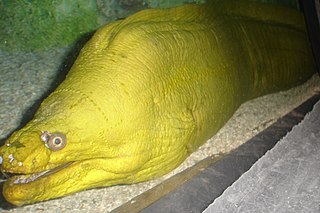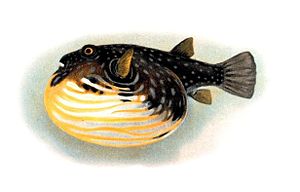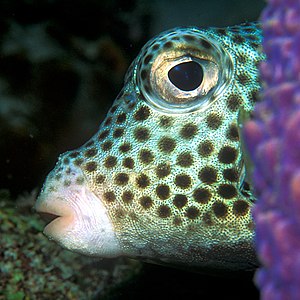
Groupers are fish of any of a number of genera in the subfamily Epinephelinae of the family Serranidae, in the order Perciformes.

Moray eels, or Muraenidae, are a family of eels whose members are found worldwide. There are approximately 200 species in 15 genera which are almost exclusively marine, but several species are regularly seen in brackish water, and a few are found in fresh water.
Ciguatera fish poisoning (CFP), also known simply as ciguatera, is a foodborne illness caused by eating reef fish whose flesh is contaminated with certain toxins. Such individual fish are said to be ciguatoxic. Symptoms may include diarrhea, vomiting, numbness, itchiness, sensitivity to hot and cold, dizziness, and weakness. The onset of symptoms varies with the amount of toxin eaten from half an hour to up to two days. The diarrhea may last for up to four days. Some symptoms typically remain for a few weeks to months. Heart difficulties such as slow heart rate and low blood pressure may also occur.

Demersal fish, also known as groundfish, live and feed on or near the bottom of seas or lakes. They occupy the sea floors and lake beds, which usually consist of mud, sand, gravel or rocks. In coastal waters they are found on or near the continental shelf, and in deep waters they are found on or near the continental slope or along the continental rise. They are not generally found in the deepest waters, such as abyssal depths or on the abyssal plain, but they can be found around seamounts and islands. The word demersal comes from the Latin demergere, which means to sink.
Ciguatoxins are a class of toxic polycyclic polyethers found in fish that cause ciguatera.

Venomous fish are species of fish which produce strong mixtures of toxins harmful to humans which they deliberately deliver by means of a bite, sting, or stab, resulting in an envenomation. As a contrast, poisonous fish also produce a strong toxin, but they do not bite, sting, or stab to deliver the toxin, instead being poisonous to eat because the human digestive system does not destroy the toxin they contain in their bodies. Venomous fish do not necessarily cause poisoning if they are eaten, as the digestive system often destroys the venom.

The green moray is a moray eel of the family Muraenidae, found in the western Atlantic Ocean from Long Island, New York, Bermuda, and the northern Gulf of Mexico to Brazil, at depths down to 40 metres (130 ft). Its length is up to 2.5 metres (8.2 ft). It is the largest moray species of the tropical Atlantic and one of the largest species of moray eel known. Though it is not considered endangered, the species is particularly under-studied and estimated to be undercounted by up to 400% in single-pass visual surveys.
Although most species in the Red Sea pose no threat to humans, there are a few notable exceptions.

The giant moray is a species of moray eel and a species of marine fish in the family Muraenidae. In terms of body mass, it is the largest moray eel; however, the slender giant moray is the largest in terms of body length.

The spotted trunkfish is a member of the family Ostraciidae. It can be found in reefs throughout the Caribbean, as well as the south western Atlantic Ocean. The species gets its name from the black spots it has covered over its whitish or yellow-golden body. In many Caribbean countries, it is colloquially known as box-fish or cow-fish, and shell-fish in the Eastern Caribbean.

Cephalopholis argus, the peacock hind, roi, bluespotted grouper, and celestial grouper, is a species of marine ray-finned fish, a member of the subfamily Epinephelinae, the groupers, and part of the family Serranidae, which also includes the anthias and sea basses. They come from the Indo-Pacific which is variously a commercial gamefish, an invasive species, and occasionally an aquarium resident. Its species name comes from its resemblance to the "hundred staring eyes" of the monster Argus who had a hundred eyes and was the shepherd of the goddess Hera in Greek mythology.

Synanceia is a genus of ray-finned fish belonging to the subfamily Synanceiinae, the stonefishes, which is classified within the family Scorpaenidae, the scorpionfishes and relatives. Stonefishes are the most venomous fish known; stings can be fatal to humans. They are found in the coastal regions of the Indo-Pacific.

Eels are ray-finned fish belonging to the order Anguilliformes, which consists of eight suborders, 19 families, 111 genera, and about 800 species. Eels undergo considerable development from the early larval stage to the eventual adult stage and are usually predators.

Fish are very diverse animals and can be categorised in many ways. Although most fish species have probably been discovered and described, about 250 new ones are still discovered every year. According to FishBase about 34,800 species of fish had been described as of February 2022, which is more than the combined total of all other vertebrate species: mammals, amphibians, reptiles and birds.

Coral reef fish are fish which live amongst or in close relation to coral reefs. Coral reefs form complex ecosystems with tremendous biodiversity. Among the myriad inhabitants, the fish stand out as colourful and interesting to watch. Hundreds of species can exist in a small area of a healthy reef, many of them hidden or well camouflaged. Reef fish have developed many ingenious specialisations adapted to survival on the reefs.

Several species of fish are claimed to produce hallucinogenic effects when consumed. For example, Sarpa salpa, a species of sea bream, is commonly claimed to be hallucinogenic. These widely distributed coastal fish are normally found in the Mediterranean and around Spain, and along the west and south coasts of Africa. Occasionally they are found in British waters. They may induce hallucinogenic effects similar to LSD if eaten. However, based on the reports of exposure they are more likely to resemble hallucinogenic effects of deliriants than the effects of serotonergic psychedelics such as LSD. In 2006, two men who apparently ate the fish experienced hallucinations lasting for several days. The likelihood of hallucinations depends on the season. Sarpa salpa is known as "the fish that makes dreams" in Arabic.

Poisonous amphibians are amphibians that produce toxins to defend themselves from predators.

Eels are elongated fish, ranging in length from five centimetres (2 in) to four metres (13 ft). Adults range in weight from 30 grams to over 25 kilograms. They possess no pelvic fins, and many species also lack pectoral fins. The dorsal and anal fins are fused with the caudal or tail fin, forming a single ribbon running along much of the length of the animal. Most eels live in the shallow waters of the ocean and burrow into sand, mud, or amongst rocks. A majority of eel species are nocturnal and thus are rarely seen. Sometimes, they are seen living together in holes, or "eel pits". Some species of eels live in deeper water on the continental shelves and over the slopes deep as 4,000 metres (13,000 ft). Only members of the family Anguillidae regularly inhabit fresh water, but they too return to the sea to breed.


















